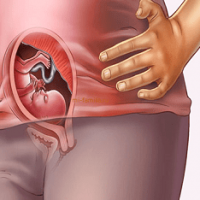 Every pregnant woman wishes for an easy, problem less delivery. Though there are several elements that determine the mode of delivery,
Every pregnant woman wishes for an easy, problem less delivery. Though there are several elements that determine the mode of delivery,
it is a common practice of the pregnant woman to analyze her chances of having an easy delivery by comparing her health condition and physical features with other ladies who had an easy and less complicated delivery.
One such physical feature of a pregnant women that is widely assumed to make the delivery easier is having bigger or wider hips. Before knowing whether having bigger hips will help you with an easy delivery, it is important to know the structure of some parts that take part in the process of delivery.
How Are Hips Related To Delivery?
It is not the hips but the pelvis that is related to the delivery. The hips and the pelvis are two well-defined but completely interconnected parts of the body which definitely have a significant role in the process of delivery. The hips are a projection of the pelvis and upper thigh bones on each side of the body. Hip bones are called pelvic bones.
What Is The Structure Of The Pelvis?
The pelvis is a semicircular bone complex with several bones joined together by means of ligaments. The three bones that form the pelvis are:
- Ilium: Among the hip bones, Ilium is the largest and the widest.
- Ischium: It is on this bone you rest your body weight while sitting. Ischium is narrower and positioned inferior to the ilium.
- Pubis: The smallest of the hip bones and positioned anterior to ischium.
The pelvic bones along with the muscles provide not only the support for growing the uterus and the baby inside but pelvic bones also provide a passage through which the baby comes into this world.
How Do Pelvic Bones Provide The Passage For The Baby During Delivery?
The pelvic bones along with the tail bone forms four joints-
- The right and
- the left sacroiliac joints
- The sacrococcygeal joint
- The pubic symphysis
Of these joints, the pubic symphysis is formed by joining the right and left pubic bones. The pubic symphysis brings together the right and left pubic bones, as it is slightly flexible. It is composed of a band of fibrocartilage that allows the pelvis to stretch during childbirth to accommodate the head of a fetus passing through the birth canal.
The stretching becomes easier as the hormone relaxin is poured into the blood stream during pregnancy and labor. This hormone softens and relaxes the ligaments that bind the pelvic bones, giving additional space for the birth canal.
Is Having Wider Hips Advantageous For An Easier Delivery?
Wider hips always refer to the wider ilium, the largest wing shaped bone of the pelvis that grows laterally and determines the width of the hip.
The fact is that the size of iliac area has nothing to do with birthing the baby. When it comes to giving birth, it is the size and shape of the round hole in the middle of the pelvis called pelvis inlet that counts. Let the size of the hip bone be very large or too small, the size of the pelvic inlet can be of the same size in both cases.
The following picture will give you an idea about the pelvic inlet which bounded:
- Anteriorly by pubic symphysis.
- Posteriorly by the promontory (ledge) of the sacrum.
- Laterally by the iliopectineal lines (a compound structure of the arcuate line from the ilium and pectineal line from the pubis).
Hence, it is not the hip size that decides the space an infant needs to go through the birth canal, but the width and shape of the pelvic inlet which contracts and pushes the baby out into the world does.
Is A Long Labor Or Long Pushing Stage An Indicator Of A Small Pelvic Inlet?
Not necessarily. There is one more significant factor that must be considered when it comes to an easy delivery – the baby. Labor time also depends on:
- Size of the baby.
- Molding of the baby’s head. The baby’s head is composed of several bones which overlap during birth (molding). It is impossible to predict which extend will the baby’s head will mold during delivery.
- Relaxing of the pelvis. How much the pelvis of the pregnant women will relax to hold the baby can’t be predicted until the mother has begun pushing her baby down the birth canal.
Therefore don’t be overly concerned about your physique when you think of an easy delivery. Let you be tall or short, having large hips or narrow hips, your body is designed to give birth. An easy delivery can’t be predicted and guaranteed even by a well experienced doctor despite the fact that your health and physical conditions are hundred per cent fine.









